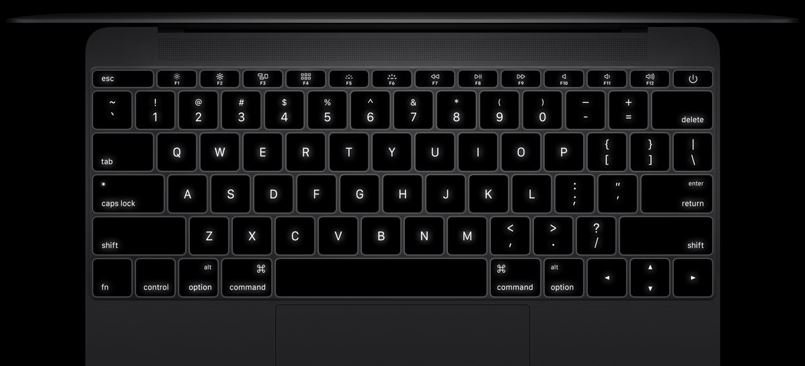To pursue its continuing obsession with thinness, Apple has gone to extraordinary lengths with the keyboard on the new 12-inch MacBook, redesigning it in a way that is thoroughly distinct from its Macbook Air and MacBook Pro stablemates.
According to Apple, the the new MacBook's key assembly is about 40 percent thinner than previous designs and was necessary to keep the entire machine under 0.52 inches thick at its deepest point.
Executing such a radical design with traditional scissor-switch keys would have cause keycaps to wobble and bottom out without registering a stroke, so Apple introduced something called the "butterfly" mechanism.
Scissor-switches are composed of two separate, relatively tall hinges, and will often descend in one corner first as a key is depressed. The "wings" of the butterfly mechanism, as seen below, tout comparatively shallow displacement and bend in unison since they're part of a single assembly crafted from stiffer materials.
The butterfly design not only improves typing precision, but importantly reduces thickness. As a trade-off, these types of keys offer very little travel, which could take some getting used to, but probably won't be an obstacle in an era of touchscreens that boast no feedback whatsoever.
On the comfort front, Apple was able to enlarge key surface area by 17 percent, offering users a larger target to strike when typing. Additionally, a new stainless steel dome switch undergirding the butterfly mechanism provides a solid feel and positive feedback.
A further space-saving measure involves the way keyboard backlighting. Many notebooks simply use one set of LEDs routed through a diffuser — or fiber optics in older Apple laptops — to light up the entire keyboard, but the new MacBook boasts separate lights under each key. The setup promises energy efficiency and uniform brightness without any light spillage around key edges.
One final change has little to do with space, precision, or other practical matters. Apple has used the same font — VAG Rounded — on its keyboards since 1999. The 2015 MacBook is the first computer to employ San Francisco, an Apple-designed font initially introduced to make text on the Apple Watch more legible.
That's unlikely to be an issue on a notebook keyboard, so the more plausible explanation for using the typeset on the MacBook is that San Francisco creates a common aesthetic across Apple's product lines while avoiding licensing fees. VAG Rounded was originally designed for Volkswagen in the late 1970s by GGK Dusseldorf, although the carmaker abandoned it in the early 1990s. It has since been used by companies such as T-Mobile and Adecco, and is now licensed by Adobe.
The new MacBook is due to ship on April 10 at a base cost of $1,299. Beyond its keyboard, it will sport a Retina display, a Force Touch trackpad, and just a single USB-C port for both input/output connections and charging.
 Roger Fingas
Roger Fingas








-m.jpg)






 Amber Neely
Amber Neely
 Malcolm Owen
Malcolm Owen
 Christine McKee
Christine McKee

 Chip Loder
Chip Loder
 Marko Zivkovic
Marko Zivkovic
 Wesley Hilliard
Wesley Hilliard









104 Comments
I can't wait to try mine out! I'm very excited about this computer's portability. It is lite and thin yet sports 8G of RAM and a 512G SSD. I will use it as my only computer. The keyboard may take some getting used to, but I'm sure it will be fine.
Regarding the typeface used on the key caps: this move is totally motivated by art direction and branding. The designer doesn't need to purchase per unit licenses for a product using renderings of a typeface. They just need licenses for the actual designer's machines. Just like I can print as many books as I like using a typeface I've licensed without paying per book. Now if VAG Rounded were installed on every Mac whose key caps were rendered in VAG Rounded, that would be a huge licensing expense. Of course, you could just subscribe to Creative Creative Cloud and use VAG Rounded all you want! (Ducking Adobe flames) Edit: looks like VAG Rounded isn't available through typekit. However, I still feel that the subtle suggestion that apple is cutting ties with adobe by using an in-house typeface is just feeding the anti-adobe trolls. Or maybe I'm reading into that part of the article too deeply?
Its not how many Ports you have, but what you Do with them ;-) that matters. Speaking of counting, I'd argue that the new Macbook has 3 "ports"; 2 Physical and another that is connector-less. USB-C (which hosts multiple data formats and POWER) is one, The second port is audio oriented but also does do digital PCM fiber. The third port went connectors-less a while back its the R/F port that provides Bluetooth and WiFi. I count (3) ports that all do double duty. Not one. :D
Will it bend?
Like I suspect many others, I like to have one keyboard design with the same feel on all my devices. Right now my Mac mini, MacBook, and iPad all use keyboards with the same Apple design. If I switch, I'd want to switch them all. Anyone know what are the chances that Apple will bring out a new standalone USB or Bluetooth keyboard with this new design, perhaps in combination with the new trackpad? The latter would be great for those who regularly shift between a desktop and laptop.